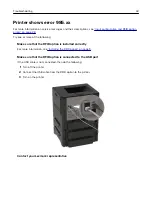
Encoding RFID tags and printing forms
The RFID tag command contains the RFID data to be encoded in the RFID tag. It also includes setup parameters,
such as tag location, read-or-write capability for the programming module, and password protection.
To send the form and the RFID tag command to the printer, use any of the following:
•
PDF document
•
PCL data stream
•
Lexmark Forms Composer
RFID Tag Command Generator
Note:
For more information, see the
RFID Tag Command Generator User’s Guide
.
The RFID Tag Command Generator is a command
‑
line utility that is used to do the following:
•
Insert a tag command into a PDF document.
•
Generate a tag command for PCL data stream or Lexmark Forms Composer.
•
Generate a parameter file to automate the PDF or PCL insertion process.
•
Define the following setup parameters for each RFID tag:
–
RFID data
–
Memory bank
–
Tag location
–
Read or write capability for the programming module
–
Source tray
–
Output file name
–
Media type and size
To download the utility and the
RFID Tag Command Generator User’s Guide
, go to
.
Encoding RFID tags using PDF documents
The built-in PDF interpreter in Lexmark printers processes and prints PDF documents without a print driver. The
RFID printer uses this feature to encode RFID tags when printing PDF documents.
Inserting the tag command into the PDF document
1
Using any application that supports the ISO 32000
‑
1:2008 standard, create a PDF document.
2
Using the RFID Tag Command Generator, insert the tag command into the PDF document.
Note:
For multiple
‑
page documents, we recommend inserting the tag command on the first page.
For example, to add the RFID data and rename a PDF document by appending
RFID
to the file name, the
command line is:
RFIDTagGen -i
INV12345.pdf
-o
INV2345RFID.pdf
-jf
parameters.json
-d
12345
Encoding RFID tags and printing forms
23






























